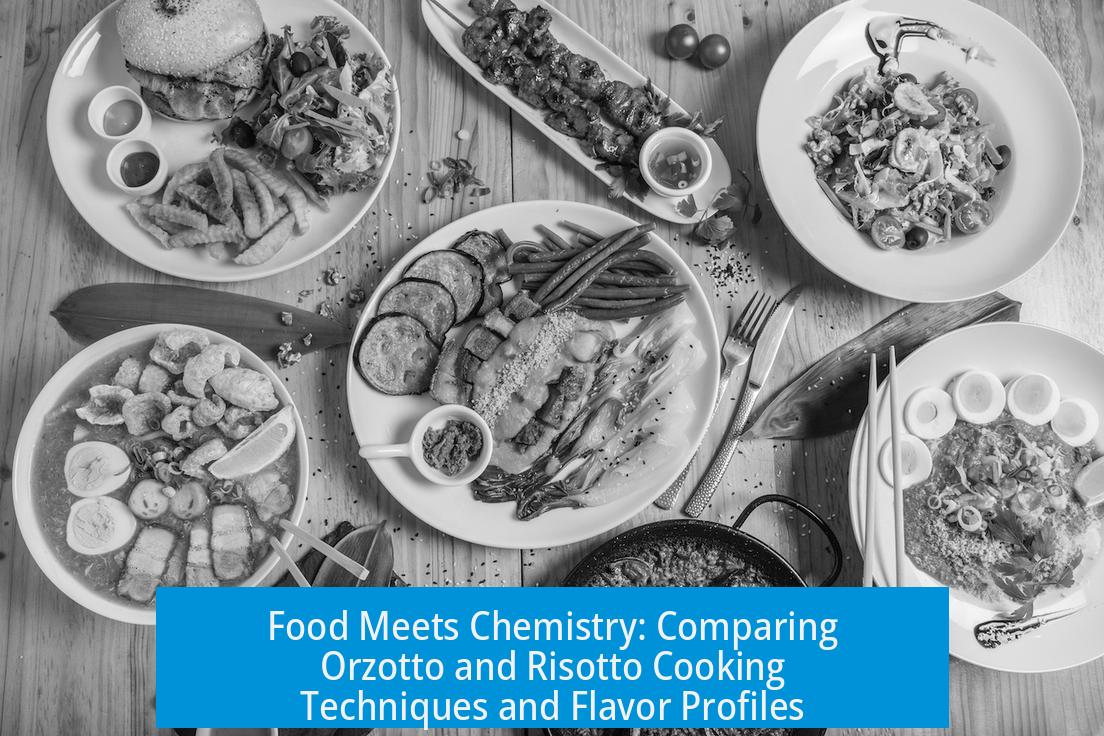Food Meets Chemistry: Orzotto vs. Risotto
Orzotto and risotto are similar dish concepts where grain is cooked to a creamy consistency, but orzotto uses barley (orzo) instead of rice. The chemistry of these grains drives differences in texture, moisture absorption, and flavor during cooking.
Understanding Risotto Chemistry
Risotto is a traditional Italian dish based on a specific type of rice. Preparing risotto well is seen as a culinary challenge, especially on cooking shows like Masterchef Australia where it’s nicknamed the “death dish.”
Risotto rice must absorb large amounts of liquid yet retain a firm texture called “al dente.” It must produce a creamy dish without becoming sticky or mushy. This balance depends largely on the chemistry of the rice starch.
Key Rice Properties for Risotto
- Moisture Absorption: The rice must soak up plenty of water or broth.
- Texture: Kernels should remain separate and slightly firm, avoiding excessive stickiness.
- Integrity: Grains must hold their shape and not disintegrate during cooking.
The standard risotto rice is Arborio, which possesses these qualities, but there are alternatives like Carnaroli, Vialone Nano, Baldo, and Roma rice.
The Science Behind Risotto Rice
Rice starch comprises two molecules: amylose and amylopectin. Amylose is a long, linear chain of glucose molecules, while amylopectin is highly branched and bulkier.
| Starch Component | Structure | Effect on Texture |
|---|---|---|
| Amylose | Linear chains | Creates loose grains, less sticky |
| Amylopectin | Branched chains | Results in sticky, gluey texture |
A balanced amylose content is key for risotto—to obtain creaminess without excessive stickiness. Typically risotto rice is intermediate in amylose content, absorbing moisture well and producing firm yet creamy grains.
Role of Chalkiness in Risotto Rice
“Chalk” refers to opaque white regions seen inside rice grains. Arborio rice has a notable chalkiness, which contributes to its distinct bite and texture preferred in risotto.
The exact chemistry of chalkiness in rice is not fully understood. However, it is thought to influence how starch granules absorb water and gelatinize during cooking.
Orzotto: Barley’s Chemistry in Cooking
Orzotto mimics the risotto style but replaces rice with barley grains, usually pearl barley or orzo (a pasta shaped like rice). Barley starch chemistry differs markedly from rice:
- Barley starch contains less amylose than rice, but the grain has a higher fiber and protein content.
- Barley has a tough outer bran layer, even in pearl barley, affecting water absorption and cooking time.
- The complex carbohydrate matrix in barley leads to a denser, nuttier texture and distinct mouthfeel compared to rice-based risotto.
Chemically, barley does not gelatinize in the same way rice does. Its starch granules swell more slowly and release less amylopectin. This results in a dish that is less creamy but has a more substantial chew.
Comparing Cooking Techniques
Traditional risotto preparation involves slow addition of stock, frequent stirring to promote starch release, and careful temperature control. This method cultivates a creamy texture by gradually gelatinizing the rice starch.
Recent scientific testing suggests that many traditional limitations can be relaxed. One may cook risotto by adding all liquid at once, using a lid, and stirring occasionally without losing much quality. This “lazy” method suits home cooks.
Orzotto, due to barley’s different starch, requires longer cooking and soaking time to soften the firmer grain. It typically involves simmering barley in broth and finishing with cheese and butter for richness, but it does not require as much stirring to promote starch release.
Flavor and Textural Differences
The starch chemistry largely influences flavor perception by affecting texture:
- Risotto: Creaminess from rice starch, slight bite due to chalkiness, smooth and cohesive mouthfeel.
- Orzotto: Earthier, nuttier notes from barley, firmer grain texture, less creamy but hearty.
Orzotto may appeal to those seeking a whole-grain option with higher dietary fiber and protein.
Recipe Insight: Making Simple Mushroom Cheese Risotto
A typical risotto recipe includes risotto rice sautéed in butter and aromatics, deglazed with wine, then slowly cooked with broth. Cheese at the end enhances creaminess.
- Key ingredients: Arborio rice, butter, onion, garlic, wine, stock, mushrooms, and a mixture of cheeses.
- Cooking involves simmering rice with liquid covering it, using a lid, occasional stirring, and finishing with cheese.
Such a method leverages the chemical properties of rice starch to yield the desired creamy texture.
Summary of Key Points
- Risotto relies on rice varieties high in amylose and possessing chalkiness, enabling high moisture absorption and a creamy yet firm texture.
- Orzotto substitutes barley, which has less amylose but higher fiber, resulting in a less creamy, nuttier dish.
- Traditional risotto preparation emphasizes slow cooking and frequent stirring to optimize starch gelatinization; recent studies show simpler methods can work.
- Orzotto requires longer cooking due to barley’s dense texture but needs less stirring for creaminess.
- The starch chemistry explains differing textures, mouthfeel, and culinary applications of orzotto and risotto.





Leave a Comment